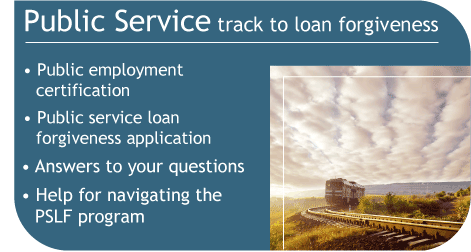Student Loan Forgiveness Programs
The Department of Personnel & Administration publishes annual, up-to-date information about eligibility requirements for federal loan forgiveness programs designed to incentivize public service and help make the State of Colorado an employer of choice. On this page you can find additional information and strategies for reducing anxiety around your student loan. Review important concepts, tips, and recommendations for repaying your student loans at Repaying Student Loans 101.
The U.S. Department of Education’s COVID-19 relief for student loans has ended. The 0% interest rate ended Sept. 1, 2023, and payments restarted in October. Additionally, the limited PSLF waiver ended and the normal program requirements for both PSLF and TEPSLF resumed.
Public Service Loan Forgiveness Program (PSLF)
If you are employed by a government or non-profit organization, you may be able to receive loan forgiveness under the Public Service Loan Forgiveness Program. The PSLF Program forgives the remaining balance on your direct loans after you have made 120 qualifying monthly payments under a repayment plan while working full-time for a qualified employer.
If you are working toward PSLF, you can use the PSLF Help Tool to assist you in starting the process.
Teacher Loan Forgiveness Program
Under the Teacher Loan Forgiveness Program, if you teach full-time for five complete and consecutive academic years in a low-income school or educational service agency, and meet other qualifications, you may be eligible for forgiveness of up to $17,500 on your subsidized and unsubsidized student loans. If you have a direct consolidation loan or a federal consolidation loan, you may also be eligible for forgiveness of the outstanding portion of the consolidation loan that repaid an eligible student or Stafford loan.
To learn more about the Teacher Loan Forgiveness Program, please visit the Frequently Asked Questions page at the Office of Federal Student Aid.
In Colorado, Senate Bill 23-084 was passed, directing institutions to either directly certify employment for the program or annually provide employees with partially completed forms to certify their employment. The act allows an institution to apply this calculation going back to October 1, 2007. Additionally, to determine if a faculty or teacher at a State or nonprofit institution of higher education is a full-time employee under the federal public loan forgiveness program, the act requires the faculty's or teacher's credit or contact hours to be multiplied by at least 4.35 to determine the number of hours worked.
Federal Student Loan Repayment Options
While you might have selected or been assigned a repayment plan when you first began repaying your student loan, you can change repayment plans, for free, at any time. Contact your loan servicer if you would like to discuss repayment options or change your federal loan repayment plan.
Learn more about how to repay your loans from the U.S. Department of Education.
For more information about local, state and federal loan forgiveness and repayment programs please visit the Colorado Attorney General's Office webpage.
Maximizing the Investment Value of your Education
Every investment we make has a return. The return on your investment in education is a direct measure of the value you receive from your educational choices relative to what they might have cost you. Visit the Colorado Department of Higher Education's webpage for additional resources, including online tools to help Coloradans maximize the return on investment they receive from the educational loans they take out over time.
